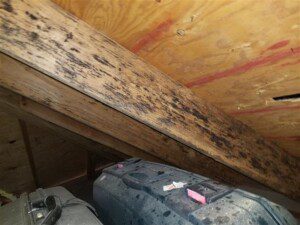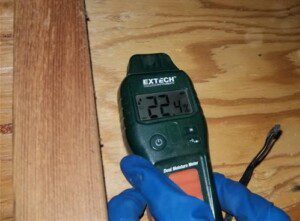
If apparent mold is found in a home, there are ways to help determine if there is a likely mold issue. One specific method is to determine whether moisture levels are elevated in the materials where apparent mold is present, and another way is to determine whether indoor air humidity levels are too high. Home inspectors can use moisture testers and humidistats to measure moisture levels in a home, and can also use infrared cameras to detect surface temperatures that could indicate a moisture issue.

So what is “lumberyard mold” (sometimes called “construction mold”), and is it a concern? Lumberyard mold refers to any mold growth that may occurred when the lumber was first cut from the tree and stored in a lumberyard. Since there is plenty of moisture, sugars and other nutrients available in wood when it is freshly cut, mold quite often can form on the wet wood surfaces. Some lumber is kiln dried, which will usually eliminate or kill any active mold growth, but for other lumber that is not kiln dried, any surface mold will usually run its course and not be considered active once it is installed in a home. If it is still active however, the wood should eventually dry to the point where the mold can no longer grow, if the wood is located in a properly vented area, or in an enclosed building assembly that has been properly installed with materials to allow moisture to diffuse through them, and evaporate over time. Current building standards requires that homes be built to be able to dry out in order to prevent mold growth issues. If wet wood is installed in a location that does not allow water vapor to be properly vented to the exterior, or escape through diffusion (such as enclosed in plastic that is not vapor permeable), then the original mold growth could persist, or new mold growth could form which could lead to indoor air quality issues, and structural damage.
If what appears to be lumberyard mold is found in a home, inspectors will usually report the presence of suspected lumberyard mold, but will also indicate that the only way to determine if there is actual mold present would require surface mold testing and laboratory testing. If requested by the client, samples of the suspected mold can be collected using swabs or tapes meant for this specific purpose. Once collected, the samples are transferred in sterile containers to a laboratory that can analyze a sample using microscopes. The laboratory will produce a report showing their findings, which will include if mold was found, and if so, what types of mold were found.
Available scientific studies show that lumberyard mold does not emit mycotoxins or cause allergen issues. If lumberyard mold is found in a home you are looking to purchase, consider having surface samples taken to determine if there are any molds present that may be harmful. In addition, you may opt for an indoor air sample, which is a better way to determine if there are actual elevated mold spore levels present the living space. Otherwise it is recommended to have any remaining staining or material left over from lumberyard removed to ensure that a future problem will not occur. If moisture levels were to build up for whatever reason, such as an unexpected roof leak, mold that has been dormant for quite some time can sometimes still become active and propagate.
Please check out the video below of a seminar given by a mold remediation contractor for more information about lumberyard and other types of mold.
